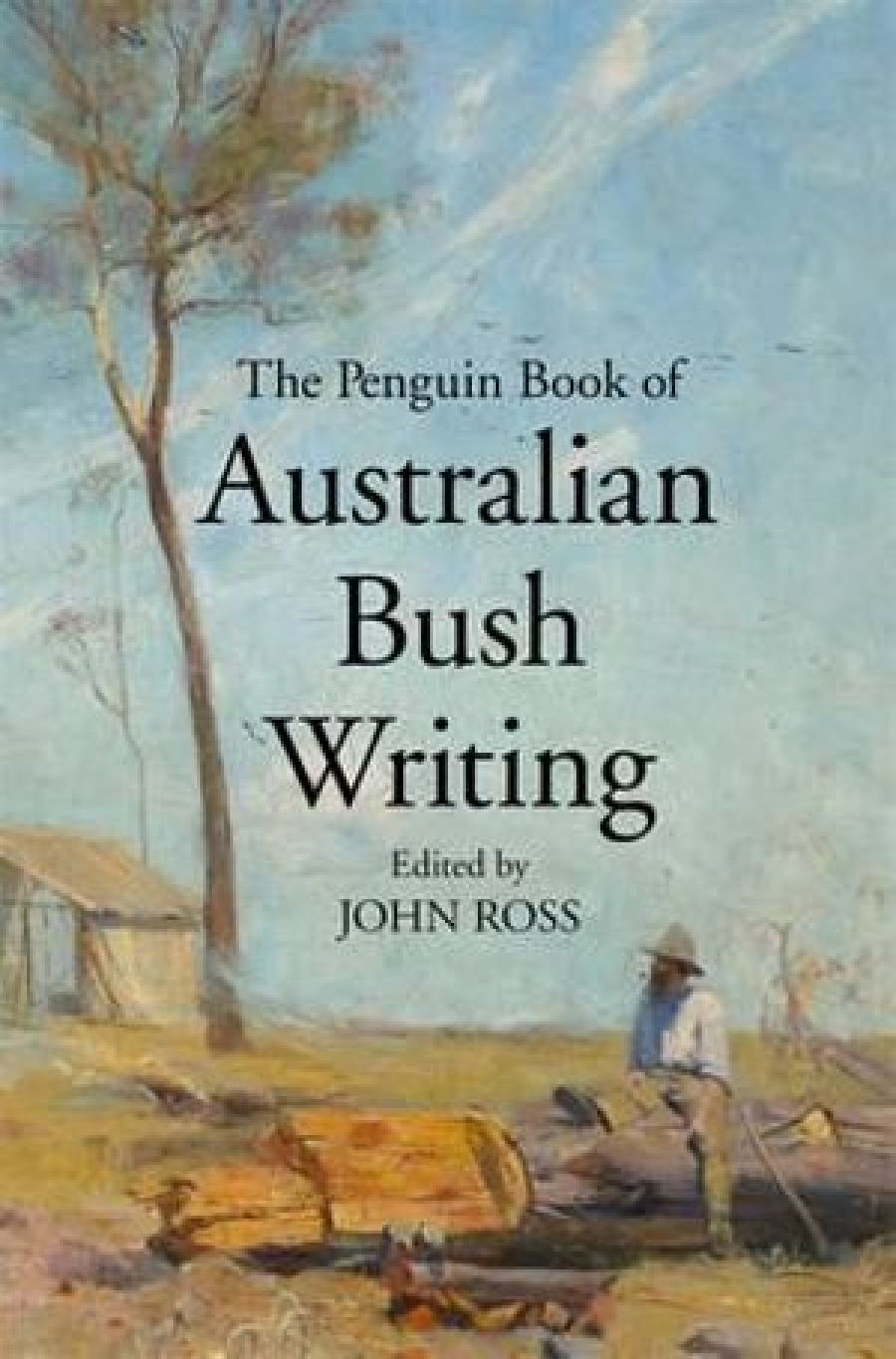
- Free Article: No
- Contents Category: Anthology
- Review Article: Yes
- Article Title: Afternoon tea
- Online Only: No
- Custom Highlight Text:
Twinings has recently introduced a new tea flavour called ‘Australian Afternoon Tea’. On the box is an image of kangaroos silhouetted against a red rocky background, which is a sort of amalgam, or perhaps amalgum, of Uluru and Kata Tjuta. This book is like that tea – more Australian than Australia, in a packaged, labelled form that relies heavily on recognition, stereotype, and sentiment. I have to admit that when I started reading the Introduction I thought it might be a parody, but perhaps that just shows jaded sensibilities. Nevertheless, I am not convinced that as ‘Australians we carry a certain vague longing for the bush’. Perhaps I am not drinking the right tea.
- Book 1 Title: The Penguin Book of Australian Bush Writing edited by
- Book 1 Biblio: Viking, $32.95 pb, 356 pp
In a recent controversy in the Melbourne newspapers about the shameful state of the study of Australian literature in Australia, one of the unspoken questions has been, ‘Why aren’t more young people reading it?’ One of the answers could be books like this. This is not a volume for those seeking the exciting, the new, the challenging, the experimental, or the unfamiliar. You could claim that its title gives the reader fair warning, but in fact there are plenty of new and experimental writers living in or writing about the bush. Perhaps the danger lies in the triple whammy of that combination: Australian, bush, and writing.
What is the bush? And what is bush writing? I sometimes ask students to locate the bush for me on a map of Australia, and it never turns up in the same place twice. It is a place of the imagination. In this anthology, bush writing is by white men, mostly writing about white men. In that white people invented the bush, a landscape alienated from the self, this is fair enough, if potentially tedious. Oddly, after a completely authoritative Introduction from the editor, locating the bush in various specific sites, there is an extract from Gerald Murnane suggesting it is after all imaginary.
As Murnane’s presence suggests, it is not that there is not good writing in the anthology; there is some Henry Lawson, Les Murray, Eric Rolls, Alan Marshall, although not always the most elegant or interesting possibilities, in that the selection seems driven by an agenda around the myth of the hostile bush, and the heroic bushman popularised by some of Lawson’s work, and the Lawson–Paterson debate. In this rather staged poetic debate in the Bulletin in the 1890s, Paterson famously took the optimistic side. The bush was an idyllic site, and he wished to change places with Clancy and go droving. The piece chosen for the Penguin Book is ‘The Trouble with Merinos’, a comic piece about how stupid and ruinous sheep are, with which Lawson’s negative persona would have entirely agreed. Mick Kelsall’s ‘Bugger Australia Altogether’ is about the difficulty of tomato farming. Murray’s detailed and loving account of the Wang Wauk forest is interspersed with the ghastly logging accidents of the past.
Perhaps the most irritating thing about the volume is that what this translates into for present-day bush stories are real-life disaster narratives. The contemporary ‘writings’ in the volume include an excessive number of accounts of encounters with natural disasters, so the bush remains a vicious foe to the end, or worse, a disaster zone, and people struggle harder to survive against her increasingly malicious onslaughts. I don’t think the bush is a girl really, but forty-five of the fifty pieces here are by men, and the majority deal with battling the onslaughts of an increasingly bitchy bush environment. It does send one scurrying back to the 1980s psychoanalytic theories of Kay Schaffer, who suggested that in the bush myth the landscape had to be figured as a feminised other in order for a coherent male self to be produced.
One would hope not, and certainly for the twenty-first century one might hope that we could come up with a bush story which was not framed inevitably around battling the elements, but around working with, and within, the bush. Part of the problem might be that ‘writing’ in this volume is interpreted as prose writing, not narrative, so that although there are ‘yarns’, there are no stories here. Most of what Ross has selected is descriptive writing, which is fine, though it does tend to derive its excitement from the harsh or Marcus Clarke’s ‘weird melancholy’ (not that Clarke is represented here). There is a brief sequence, with an account of Lake Frome by Tim Flannery, and a lyric description of camping in the Tasmanian Central Plateau by Chris Bell, which suggests another way of writing the bush. These frame the piece ‘Ceremony’ by Ros Moriarty, which narrates a white woman’s inclusion in Indigenous women’s ceremonies. The latter fulfils the dual purpose of token woman’s account, and even worse, token Indigenous account. All three offer a positive view of very different bush experiences. However, for Flannery and Bell, although they are not battling the wilderness, it is still represented as an extreme environment. Even the two and a half pages from Edna Walling praising the native flowers of Kosciusko warns that the Snowy River Scheme may sweep them away.
This volume is full of good things. The Australian Afternoon Tea tastes pretty good, too. In both cases, the packaging is at fault, limiting access to the contents, constraining their possible configuration and interpretation, and turning readers and consumers away in weariness at the lack of a fresh idea.


Comments powered by CComment